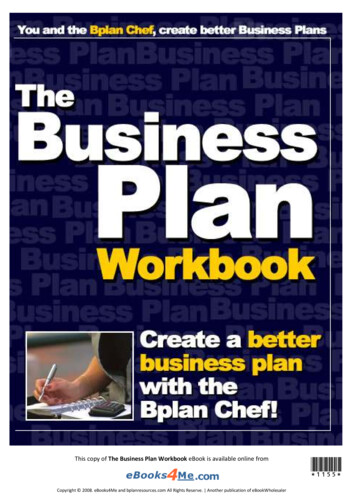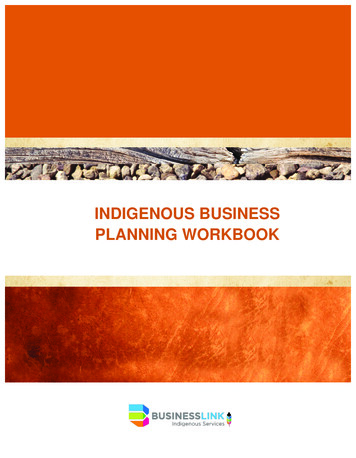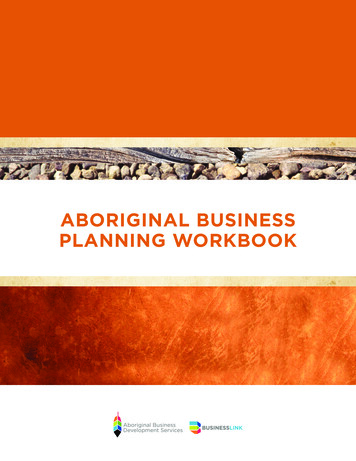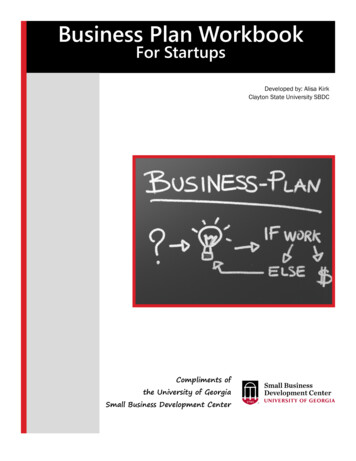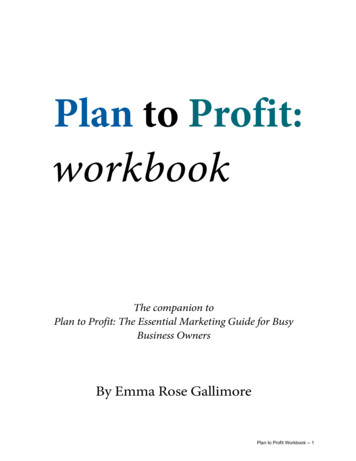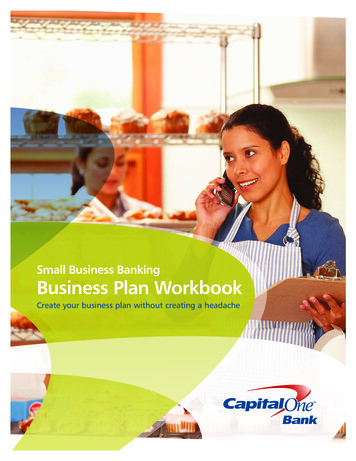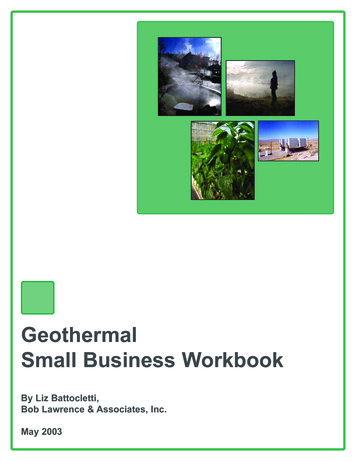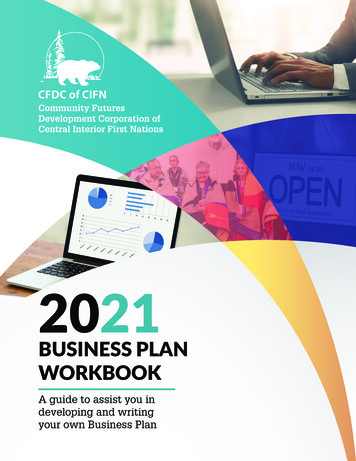
Transcription
Community FuturesDevelopment Corporation ofCentral Interior First Nations2021BUSINESS PLANWORKBOOKA guide to assist you indeveloping and writingyour own Business Plan
22021 CFDC of CIFN Business Plan Workbook
SECTION 1Are you ready to become an entrepreneur?A. What are some advantages that you can identify? . . . . . . . . . . . . . . 4B. What are some disadvantages that you can identify? . . . . . . . . . . . . 4C. Characteristics of a business owner/entrepreneur . . . . . . . . . . . . . . 4D. Identify your strengths and passion that reflect your work qualities . . . . 5E. How will your business ownership be structured? . . . . . . . . . . . . . . 5SECTION 2Are you ready to start writing your business plan?What is a business plan and why do you need one? . . . . . . . . . . . . . . . 6SECTION 3Business PlanA. Executive Summary . . . . . . . . . . . . . . . . . . . . . . . . . . . . . . . 7B. Business Description . . . . . . . . . . . . . . . . . . . . . . . . . . . . . . . 7C. Mission/Vision Statements . . . . . . . . . . . . . . . . . . . . . . . . . . . 8D. Products/Services . . . . . . . . . . . . . . . . . . . . . . . . . . . . . . . . 9E. Management . . . . . . . . . . . . . . . . . . . . . . . . . . . . . . . . . . . 9F. Operations Plan . . . . . . . . . . . . . . . . . . . . . . . . . . . . . . . . . 10G. Risk Analysis . . . . . . . . . . . . . . . . . . . . . . . . . . . . . . . . . . . 10H. Marketing Plan . . . . . . . . . . . . . . . . . . . . . . . . . . . . . . . . . 11I. Market . . . . . . . . . . . . . . . . . . . . . . . . . . . . . . . . . . . . . . . 11J. Pricing of your goods/services . . . . . . . . . . . . . . . . . . . . . . . . . 12K. Customer Service . . . . . . . . . . . . . . . . . . . . . . . . . . . . . . . . 12L. Advertising and Promotion . . . . . . . . . . . . . . . . . . . . . . . . . . . 13SECTION 4Financial statements/projectionsA. Financial Project Plan . . . . . . . . . . . . . . . . . . . . . . . . . . . . . . 14B. Financial Projections . . . . . . . . . . . . . . . . . . . . . . . . . . . . . . 15C. Break Even Calculation . . . . . . . . . . . . . . . . . . . . . . . . . . . . . 16D. Balance Sheet Template . . . . . . . . . . . . . . . . . . . . . . . . . . . . 17E. 12-Month Profit and Loss Projection Template . . . . . . . . . . . . . 18-19F. Income Statement . . . . . . . . . . . . . . . . . . . . . . . . . . . . . . . . 20SECTION 5Additional informationA. General Frequently Asked Questions: . . . . . . . . . . . . . . . . . . . 21-23B. Financial Frequently Asked Questions . . . . . . . . . . . . . . . . . . . . 24C. Businesses On Reserve Frequently Asked Questions . . . . . . . . . . . . 25D. Glossary . . . . . . . . . . . . . . . . . . . . . . . . . . . . . . . . . . . . . 26E. Checklist for starting a business . . . . . . . . . . . . . . . . . . . . . . . . 27F. I nformation on Community Futures . . . . . . . . . . . . . . . . . . . . . . 28Corporation of Central Interior First NationsG. I nformation on other organizations . . . . . . . . . . . . . . . . . . . . . . 28Use this workbook to assist you in determiningif you are ready to become an entrepreneur, or ifyou have already been in small business and youare needing to expand your business operationsand attract investors, partners or a lender.The intention of this workbook is for youto compile your own information, identifywhere you need to do some research andobtain more information, and allowing youto obtain all the necessary informationto develop your own business plan.You are your own expert, you know yourpassion, you know your expertise, strengthsand challenges, and no better person towrite your own plan than yourself.Community Futures Development Corporationof Central Interior First Nations promotesand provides community economicdevelopment support services to Indigenouspeople within the central interior of BC.CFDC of CIFN provides support toIndigenous entrepreneurs who require: ftercare advisory services.A Workshops on business development. Guidance to assist in businessloan and operation ready.Mission and VisionPromoting regional economic growth throughbusiness development services and trainingby supporting Indigenous entrepreneurs andcommunities to become financially independent.To be recognized as a regional leader incommunity economic development.2021 CFDC of CIFN Business Plan Workbook3
SECTIONONEAre you ready to become an Entrepreneur?Identify firstly that you wish tobe a business owner/entrepreneurA. What are some advantagesthat you can identify? Be your own boss Create your own income Expand/grow your business atyour own comfort level Set your own goals Make your own decisions about your business Build on your current skills and expertise Have a sense of pride to own your business Contribute back to the communitybased on what you like Other advantages important to youB. What are some disadvantagesthat you can identify? Not much money is generated in the first year You have to work long hours/weekends You spend more time at developing yourbusiness and less time with friends and family There are risks involved, suchas time/money/value It takes time to “open your doors” for business You do not have benefits like you did whenyou worked for someone else (medical/dental) You need to motivate yourselfand your employees There are more responsibilities Can you list out other disadvantages You may require some external supportC. Characteristics of a businessowner/entrepreneur 4InnovativeRisk TakerSelf-confidentPro-activeCompetitiveProblem solvers ChallengerCommunicatorMotivationalSelf MarketerOpportunist2021 CFDC of CIFN Business Plan WorkbookYOUR NOTES
SECTIONONEAre you ready to become an Entrepreneur?YOUR NOTESD. I dentify your strengthsand passion that reflectyour work qualities W hat types of businesses could youbuild on from your passion? What type of industry are youmost knowledgeable in?And you have narrowed it down to:And what will you sell (goods/services)?Based on your findings above, yournew business venture will be:E. H ow will your businessownership be structured?You will need to determine how your business will bestructured. Some questions to ask yourself would be? Are you in business by yourself? If no, is your business partner a spouse? Are all partners Indigenous? Depending on how you want your business tobe defined as, do you want your business tohave at least 51% Indigenous ownership? Why?Factors to consider: Taxation Liability Types of ownership structures Sole Proprietor Partnership Limited Partnership Limited Company2021 CFDC of CIFN Business Plan Workbook5
SECTIONTWOAre you ready to start writing your business plan?What is a business planand why do you need one?A business plan is a document that can guideyou to manage your business well. It will helpyou analyze your market and strategize yourmarket and promotional activities. You canuse your business plan to strategize yourbusiness growth within a period that youdetermine based on your expertise of thebusiness, the industry, and your market.In most cases, business plans are developedbecause the business owner requires capitalto commence the business. Capital could beinvestments from others including a lender.Loan capital is required for most businessstart ups, and the lender will require abusiness plan to ensure that the businessis viable and feasible to pay back debt.A business plan also includes a financial sectionthat outlines the current financial position ofthe company and financial forecasts based onprojections of sales that the business will obtain.A strong key success factor in your businesswould be to write your own business plan.You may require assistance from a mentor/colleague or consultant to assist you invarious sections of your business plan.Put some timelines on the development ofyour business plan and strategize your businessstart up time in the most ideal time of yearthat fits the industry of your business well.In addition to this workbook, there are manyresourceful websites on the internet that couldassist you in your business start up. Organizationsand website samples are listed on page 28-30.Also, if you require loan capital for your businessstart up, research what types of loan programsare available to you and get to know andunderstand these loan programs and their criteria.This will assist you in structuring your business.62021 CFDC of CIFN Business Plan WorkbookYOUR NOTES
SECTIONTHREEBusiness PlanYOUR NOTESA. Executive SummaryAlthough this section is first in the business plan,it is often written last. This section outlines ashort overview of all the important facts of yourbusiness. Summarize what your business name andwhat the goods/services are, as well the industry.Also include what the main objective is ofyour business. If you are attracting investors orrequesting a business loan, identify that in thissection with a brief description of what you require.B. Business DescriptionThis section should outline the basic detailsof your business. Include your full contactinformation such as your full name, telephone,email, and mailing address. If you already have awebsite, include that in this section. The readerwould like to know all about you, so includeall your business social media accounts.Provide clarity on how your business is/will bestructured, and who the owners are. If yourbusiness has been established already, includea paragraph on the history of the business.Does your business have a legal nameand a different legal address, if so,include that in these sections?2021 CFDC of CIFN Business Plan Workbook7
SECTIONTHREEBusiness PlanC. Mission/Vision StatementsThis is a good time to start to think about yourmission and vision statements. Know and rememberthat this is your business, and you can changeyour mission and vision statements anytime.Mission StatementAn action-based statement that declaresthe purpose of a business and how it willserve the customers. Sometimes it includes adescription of the company and what it doesand its objectives. A mission statement is ashort summary of the business’s purpose.Vision StatementIs an inspirational statement of an idealisticemotional future of a business. It describesthe basic human emotion that the ownerintends to be experienced by the people/community it interacts with. It outlines theimpact it will make to the industry it serves.82021 CFDC of CIFN Business Plan WorkbookYOUR NOTES
SECTIONTHREEBusiness PlanYOUR NOTESD. Products/ServicesIn this section you will outline whatyou will “sell” to your customers. Thiswould be either goods or services.List out your items or provisions. Describemajor groupings if applicable.If your business has a long list of products orservices, it can be detailed in one of the appendices.If applicable, what is your distribution,is it direct or wholesale?What is your pricing set at? How can yousummarize this section without divulgingtoo much of your information?List out what your payment terms would beand what payment system you have in place.Are there any other production detailsthat you can summarize?E. ManagementIntroduce the key people who will be managingthe business and supporting operations. List outthe roles and responsibilities of each key person.These key people may not be identified at thispoint; however, the positions should be identified.Have you set a wage or salary for these keymanagement positions? You can identify that here.Are there any mentors or types of mentorsthat need to be sourced out. State theimportance of these roles that prove to bea strength in the business operations andthe overall success of the business.Talk to your colleagues/friends and formulate acircle of mentors and resourceful people that couldprovide you suggestions to your business startup.2021 CFDC of CIFN Business Plan Workbook9
SECTIONTHREEBusiness PlanF. Operations PlanSummarize how the business will operate. List outthe facility/location and the equipment. If you arephasing out the operational plan, list that here.What are your goals in the operations strategies?And lastly, what are the timeframes of these goals?G. Risk AnalysisBeing realistic with your business is key.Outline all the risks you know that couldaffect the success of your business.Identify how these risks can be mitigated.Know that there are two types of risks.1. Controllable risks – those than can notnecessarily be prevented but they can beminimized, such as having insurance2. Uncontrollable – those that would have ahuge financial impact such a large new competitor within your market area, economyrecessions, new and improved technology,change in trends, price wars, and a pandemicthat affects all.Identify what steps can be taken toreduce or eliminate these risks.Comment here what your SCOTs are:StrengthsChallengesOpportunitiesThreats102021 CFDC of CIFN Business Plan WorkbookYOUR NOTES
SECTIONTHREEBusiness PlanYOUR NOTESH. Marketing PlanThis is one of the most vital sections of a business plan.List out your marketing objectives and includedates and strategies for each objective.Why would this be important? To make orincrease your profits, increase your salesvolume, or attain income levels.Focus on what you plan to achieve and makesure each objective is possible to achieve.For each objective, break down thesteps to achieving each one.Do your market research. Who is your customer,where are your customers? How will yourcustomers purchase your goods/services.What market research have you compiled?What are the market trends, what are theconditions? Where are your competitors? Whatwould you expect your market share to be?I. MarketList out your market. Identify the location of yourmarket. Is it community based or provincial or national?Show that you have done research on themarket, this shows that you have identifiedthe viability of your business startup.Having a sound foundation of market researchwill assist you in determining your financialforecasts (later in this workbook).Identify if there are any seasonal lowsand highs to your market. How are yougoing to manage these fluctuations?List out any strengths and weaknesses tothe market, include any competitors.How are you going to establish a marketshare in the industry of your business?2021 CFDC of CIFN Business Plan Workbook11
SECTIONTHREEBusiness PlanJ. Pricing of your goods/servicesIt will be assumed that you know how you will setyour prices. Summarize how you will be doing that.You may want to identify some of your competitorpricings in this section. And that will allow youto determine what the average pricing is.Are there any governing laws to the pricing ofyour goods/services, if so, identify here.How will your customer pay for your goods/services? What functions will you have in place andwhat options will you offer to your customers?Is your new business something that developedfrom a hobby of yours? Now is the time tothink about making it a profitable business.K. Customer ServiceThis reflects your mission and visionstatement. How important is customerservice to you and your business?How will you review the successof your customer service?How is responsible for quality andconsistent customer service?Will you have any rewards or perksto returning customers?In your business plan, comment on howimportant customer service will be andhow is it a key success factor.122021 CFDC of CIFN Business Plan WorkbookYOUR NOTES
SECTIONBusiness PlanYOUR NOTESTHREEL. Advertising and PromotionHow important is ongoing advertising andpromotion to the success of your business?What are your advertising strategies and goals?What methods will you use to advertise?It is important to identify your strategy inadvertising and promotion to ensure that you aremaintaining and growing your customer base.It is also important to understand all methodsof advertising pertinent to your businessand your customer demographics.How often will you advertise? How oftenwill you revisit your advertising tasks?Do you have a logo to your business?Do you have a slogan?Will you outsource your advertising strategies?Many businesses have built success onhaving a corporate culture? How do youwant to promote your corporate culture?What does that mean to you?2021 CFDC of CIFN Business Plan Workbook13
SECTIONFOURFinancial statements/projectionsPlease pay particular attention to this section of your business plan. Understanding all the necessary financialcomponents of your business plan and business operations will be vital to the success of your business.Having a complete and thorough financial plan will not only allow you to continue to use yourbusiness plan as a financial guide and to generate profits, it will allow your reader (investoror lender) clarity on the reason they are reading and assessing your business plan.A. Financial Project PlanThis section will include a table. It’s called Sources and Uses. It is important that as owner,you know what funds are needed and why. Ask yourself, “what dollars do I need to startup my business, and in what time period will these dollars be available to me before I canfully operate my business with no additionally funding (investment or loan) dollars.”While doing research on types of loans that could be available to you and what loans you would qualifyfor, you are making a proposal on those dollars and you highlight that in this section. Some lenders willnot lend towards some of your costs, such as some operating costs like debt repayment or wages and mayhave restrictions on some eligible costs, such as non-arms length transactions, older, used equipment or ifthey include vendor financing. Other factors influencing lending or funding decisions: your experience orlevel of involvement; your business may operate in an industry that might be considered either exploitativeor contrary to the values of that lender; demonstrated need; or creation of Aboriginal employment.While doing this research, be mindful that you are required to inject your own dollars into the start up ofyour business. This is often called “Owners Equity”. For loans and grants, there could be a range of equityrequirements that you will need to know. The more equity (your own dollars) you put into your business, theless you need to borrow. Your business project is much stronger when you put more equity into the business.A sample Sources and Uses table is as follows:SOURCES%USES%Equity 10%Equipment65%Loan 70%Working Capital28%Grant 20%Marketing8%TOTAL TOTAL100%Know what minimal equity you need to qualify for various loans/grants.Consider allowing a margin for extra costs or unexpected increased costs, sometimes called “contingency”.Include a narrative of how vital the required funds are and how it contributes to the success of the business.YOUR NOTES142021 CFDC of CIFN Business Plan Workbook
SECTIONFinancial statements/projectionsYOUR NOTESFOURB. Financial ProjectionsGenerally, this section should includefour documents. They are: Balance Sheet Income Statement Projected Cash flow Break even AnalysisBalance Sheet & Income Statement wouldbe necessary if your business already existedand was generating income. A Balance Sheetcould also be included if you are starting outyour business, and would like to show yourassets, equipment, cash at start up month.A Balance Sheet is a statement that lists out assetsand liabilities of a business at a specific point of time.An Income Statement is a statement that identifiesthe businesses revenue and expenses over aperiod of time. The difference between revenueand expenses will be the profit or net revenue.Table Balance Sheets and Income Statementsare included on page 17-20.2021 CFDC of CIFN Business Plan Workbook15
SECTIONFOURFinancial statements/projectionsC. Break Even CalculationBreak Even Calculation allows you to determinewhat you need to sell (monthly and annually) tocover all your costs (including debt servicing).Knowing what your break-even point is crucial,as you need to pay your expenses and loanpayment, but you also have to pay yourself.Break-even is when your total revenue equalsyour total costs. Break-even is a point thatyou do not make a profit or a loss. When yourrevenue is more than your break even, is whenyou will generate a profit for your business.Finding out what your break-even is willhelp you determine if you need to increaseyour prices or cut down some expenses.To calculate what your break-even is, you firstly haveto identify what costs are variable and what costsare fixed. Fixed costs are those costs that remainthe same, no matter what your revenue is. Exampleswould be your loan payment, rent, and insurance.Variable costs are costs based on your sales activity.Examples would be your direct materials and labour.The formula to calculateyour break even is:Break Even Fixed Costs/(Sales Per Unit - Variable Costs)Here’s an example:A toy store has fixed costs of 6,000 per month.And the product (toy) has a variable cost of 25.The sales price for that toy is 50. Therefore:Break Even is: 6,000/( 50- 25) 240This means that 240 toys must be sold permonth to meet all costs, that is the break even.162021 CFDC of CIFN Business Plan WorkbookYOUR NOTES
SECTIONFinancial statements/projectionsFOURD. Balance Sheet TemplateYour Business Name:FIXED ASSETSLand and Buildings0.00Motor 0Total Fixed Assets0.00DEPRECIATIONLand and Buildings0.00Motor 0Total Depreciation0.00Value of fixed assets0.00CURRENT ASSETSBank Account - Current0.00Bank Account - Savings0.00Cash0.00Prepayments0.00Accounts Receivable0.00Total Current Assets0.00CURRENT LIABILITIESAccounts Payable0.00Loan0.00Accruals0.00Total Current Liabilities0.00Net Assets0.00EQUITYOpening Balance0.00Shareholder funds0.00Retained Earnings0.00Drawings0.00Total Equity0.002021 CFDC of CIFN Business Plan Workbook17
SECTIONFOURFinancial statements/projectionsE. 12-Month Profit and Loss Projection TemplateJanuary - JuneCompany name:Fiscal Year Begins Jan-21January-2021February-2021REVENUE (SALES)Category 1Category 2Category 3Category 4Category 5Category 6Category 7Total Revenue (Sales)COST OF SALESCategory 1Category 2Category 3Category 4Category 5Category 6Category 7Total Cost of SalesGross ProfitEXPENSESSalary expensesPayroll expensesOutside servicesSupplies (officeand operating)Repairs and maintenanceAdvertisingCar, delivery and travelAccounting and legalRent & Related CostsTelephoneUtilitiesInsuranceTaxes (real estate, etc.)InterestDepreciationOther expenses (specify)Other expenses (specify)Other expenses (specify)Misc. (unspecified)Total ExpensesNet Profit Before TaxesIncome TaxesNet Operating Income182021 CFDC of CIFN Business Plan WorkbookMarch-2021April-2021May-2021June-2021
SECTIONFinancial statements/projectionsFOURJuly - DecemberCompany 1November-2021December-2021REVENUE (SALES)Category 1Category 2Category 3Category 4Category 5Category 6Category 7Total Revenue (Sales)COST OF SALESCategory 1Category 2Category 3Category 4Category 5Category 6Category 7Total Cost of SalesGross ProfitEXPENSESSalary expensesPayroll expensesOutside servicesSupplies (officeand operating)Repairs and maintenanceAdvertisingCar, delivery and travelAccounting and legalRent & Related CostsTelephoneUtilitiesInsuranceTaxes (real estate, etc.)InterestDepreciationOther expenses (specify)Other expenses (specify)Other expenses (specify)Misc. (unspecified)Total ExpensesNet Profit Before TaxesIncome TaxesNet Operating Income2021 CFDC of CIFN Business Plan Workbook19
SECTIONFOURFinancial statements/projectionsF. Income StatementREVENUEAmountCompany NameCurrent MonthAmountPeriod ending dateYear to DateAmountCompany NameCurrent MonthAmountPeriod ending dateYear to DateAmountCompany NameCurrent MonthAmountPeriod ending dateYear to DateAmountCompany NameCurrent MonthAmountPeriod ending dateYear to DateGross salesLess sales returns and allowancesNet salesCost of SalesBEGINNING INVENTORYPlus goods purchased/manufacturedTotal goods availableLess ending inventoryTotal cost of goods soldGross profit (loss)Operating ExpensesSELLINGSalaries and wagesCommissionsAdvertisingDepreciationTotal selling expensesGENERAL/ADMINISTRATIVESalaries and wagesEmployee benefitsPayroll taxesInsuranceRentUtilitiesDepreciation and amortizationOffice suppliesTravel and entertainmentPostageEquipment maintenance and rentalInterestFurniture and equipmentTotal General/Administrative expensesTotal operating expensesNet income before taxesTaxes on incomeNet income after taxesExtraordinary gain or lossIncome tax on extraordinary gainNet Income (Loss)202021 CFDC of CIFN Business Plan Workbook
SECTIONAdditional information that will assistyou in developing your business planA. General FrequentlyAsked Questions:How do I register my business name?You must have your business name approved prior toregistering your business. You can access the requiredform from the internet, www.onestopbc.ca or youcan go to your nearest Government Agents office.There is a fee for this service. When completing theform you will be asked to come up with three possiblenames with your top priority listed as number 1.FIVEHow do I approach a bank?When a bank assesses your application for fundsthey will look at four key factors: Character,Capacity, Cash F low and Collateral. (The 4 C’s)Character – A bank tries to evaluate your ability tomanage the business. You must show that you haveexpertise, skills, determination and self-confidencenecessary to be a successful businessperson.Capacity – Your business plan must be clear,structured and include all the right parts.Once your business name is approvedit will be reserved for 56 days.Cash Flow – A bank wants to know yourpersonal worth to judge your ability to repayyour loan and meet your financial obligations.Do I need to open a business bank account?Collateral – Banks will ask for some investmentfrom you as proof of your commitment.Most banks will require proof that you have registeredyour business with the Corporate Registrars officeprior to opening a business account for you.How do I get money to start up?Some entrepreneurs have provided their ownbusiness financing by using their savings.Others go through banks or other lendingagencies to obtain business loans.There are also government programs thatprovide loans for Aboriginal business owners.For more information visit the Aboriginal BusinessService Network at www.cbsc.org/absnWhat is the difference betweenloans and equity?Loans have to be repaid within acertain amount of time.Equity is the value of all contributions you maketo the business from personal resources such ascash, equipment, time and energy invested etc.Because individuals living on-reserve may notbe able to provide the necessary collateral, theother three key factors become very importantto the bank. It is important that you are thinkingabout starting a business, you establish a goodworking relationship with your bank or creditunion and maintain an excellent credit rating.What kind of business recordsdo I need to keep?Whether you are a sole proprietor, corporation orpartnership you have to keep an efficient recordand accounting system. It is recommended youcontact the nearest Canada Customs and RevenueAgency office for relevant forms, information onexpense deductions, income tax forms etc.For more information contact:Canada Customs and Revenue Agency, Tax ServicesVancouver District Office1166 West Pender StreetVancouver, BCV6E 3H8Business Enquiries: 1-800-959-55252021 CFDC of CIFN Business Plan Workbook21
SECTIONFIVEAdditional information that will assistyou in developing your business planWhat is market research?Research gives the business ownerinformation about potential and existingcustomers, competition and the industry.What is the difference betweenprimary and secondary research?Primary Research:Primary research is information collected by interviewor questionnaire designed for a specific need.Secondary Research:Information that has already been gathered bysomeone else ie. Government organizations, StatisticsCanada, trade associations, chambers of commerce.What kind of research will I have to do?You will need to research the following:Customer: Who are they? Where do they live? How much do they make? What’s their occupation? What is their lifestyle? Why are they buying? How much are they buying?Industry: Actual and potential size of the industry. Is the industry predicted to grow? Trends in the industry. What are the skills needed for the industry?What are business ethics?Ethics are moral obligations placed on businessowners in a community to be fair and honest in alltheir business dealings with customers and suppliers. What is good and evil? What is right and wrong? Just and unjust.Are there any payoffs for practicinggood business ethics?By dealing fairly and honestly with peoplethey will come back to us for more businessand hopefully make referrals.Acting ethically can keep you safefrom any kind of legal trouble.Questions to ask yourself.
BUSINESS PLAN WORKBOOK A guide to assist you in developing and writing your own Business Plan. 2 2021 CFDC of CIFN Business Plan Workbook. Use this workbook to assist you in determining if you are ready to become an entrepreneur, or if you hav

